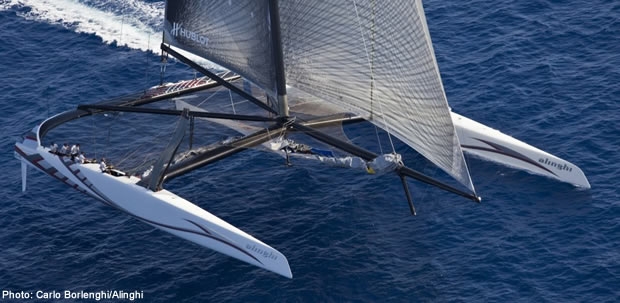
The PhDs on Alinghi 5
While the BMW Oracle Racing trimaran is now effectively in its third iteration, with the solid wing its fourth rig, considerably fewer significant changes have been made to its counterpart, Alinghi 5. This is partly due to the Swiss cat having only been launched in July 2009, some 11 months after the American tri, but also, Alinghi point out, pointedly, because they haven’t had the same seemingly limitless resources of Ellison’s team.
"The boat, here in the water, is as it was launched in Switzerland. The only changes have been the appendages, foils and rig," claims Chief Designer, Rolf Vrolijk.
While Alinghi were late starting - the ‘go’ button pressed, but then released and pressed once again, in timing with NY Supreme Court cases being won and Appeal Court decisions overturning them - at least they had the advantage of having a good idea of what BMW Oracle were conjuring up thanks initially to the vital statistics in their original Notice of Challenge specifying a 90 x 90ft platform and thus a trimaran.
"By knowing that it is a boat that wide, you know also it is a boat with quite high stability, because they can’t build it very light as they have to keep the beam [at 90ft]. So you basically know what your starting stability and righting moment are," explains Vrolijk as to their design process. "To match that with a catamaran is not that easy, because the catamaran has a different beam to length ratio - with a narrower beam and lower stability, flying earlier - all those things."
So part of their design process, once they had decided upon effectively creating a 2.5x version of Ernesto Bertarelli’s 41ft Jo Richards-Sebastien Schmidt designed Le Black, with fore and aft rig tension provided by its unique Y-shaped fore and aft spines/dolphin strikers, was to make an educated guess at the righting moment of the USA tri and then carry out a study of weight and sail power to establish the optimum beam for the anticipated conditions.
"We were convinced by going to a catamaran with the spine system we could build a lighter boat - that was the idea from the start," continues Vrolijk. "It was just a matter of how wide you can go and still be competitive and still have the original advantage." The end result is that they opted for a beam around 2-2.5m narrower than the 90ft wide trimaran.
In terms of the conditions Alinghi 5 was designed to race in, Vrolijk claims that at the time they designed her they weren’t certain of the venue, but in order to work to something, chose Valencia, where he says they could expect the sea breeze to build during the day from around 7-8 knots up to 14-18, by the end of the race. "So you have a boat that has to be good in the light stuff up to the first mark, and then you have to have a light boat because that is the best concept to go downwind again. So that is how we came to this. That is why that this is the best option and we still think today we’d have the same concept if we started again."
Vrolijk says that it was always in their plan to increase the rig height incrementally, which would leave them with two rigs - big and small - which they could plug in each day (18ft skiff-style) according to the forecast. Their second mast (they have only two) was delivered while they were in RAK and is just over 60m tall (compared to BMW Oracle’s 68m solid wing). This, says Vrolijk, they considered to be the maximum size they could handle upwind without compromising performance (there comes a time, when drag starts to outweigh the benefit of added sail area).
Vrolijk adds that when they scaled up the rig they were also concerned about balance issues that might arise, which is why they increased the length of their forward spine, to give them more options with headsail size, especially for reaching and downwind legs.
Since November, when they made the modifications to the rig and spine system, they haven’t otherwise radically changed the rig. In fact due to the rather permanent modifications to the spine system, they have also chosen to lengthen their first mast, so that too is now just over 60m. "We are comfortable, because we’ve learned how to sail the boat [with that configuration] and sail it in breeze, we know the forces in the system, what the limits are and that was basically the point where we made the decision to take this concept to Valencia and not change anything," says Vrolijk.
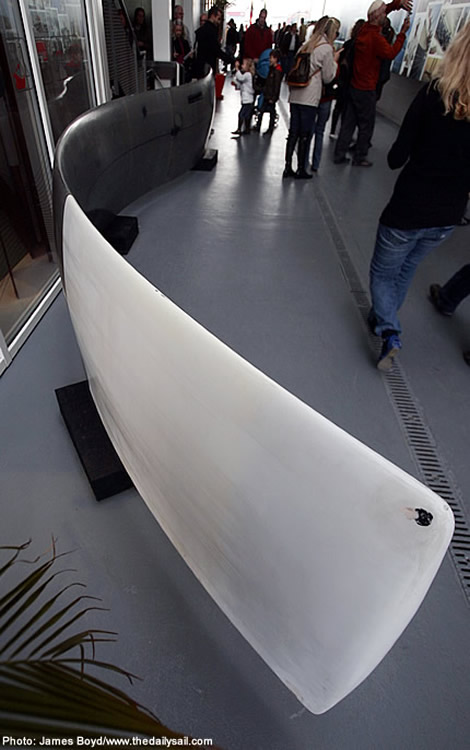
Curvy foils
In addition to the rig, they have been changing the foils. During the initial design phase they carried out all manner of experiments with the foils on the team’s plethora of smaller cats including a straight up-and-down foil and a curved lifting foil in each hull to inverted T-foils, etc. Design team member Luc Dubois even fitted ORMA 60 float-style retractible C foils on his A-Class cat – the configuration BMW Oracle now have, albeit with less curvature and the additional ability to cant them hydraulically.
When Alinghi 5 was first launched they used some interesting S-shaped foils, the idea being that they wanted one set of daggerboards that could both prevent leeway upwind while also producing vertical lift. ORMA 60 tris achieve this by having a daggerboard in their centre hull and a curved C-shape board in each float. The S-shaped board was a clever attempt to achieve both in one hit. "The moment you retract the foil you increase the angle but you reduce the area, so you reduce the side force but you increase the vertical force, so you come closer to the C-foil," explains Vrolijk.
Alinghi appeared to have reverted to the simplest option of straightforward up and down boards until this morning. However as we write they have just fitted new boards that have a very slight S-shape to them.
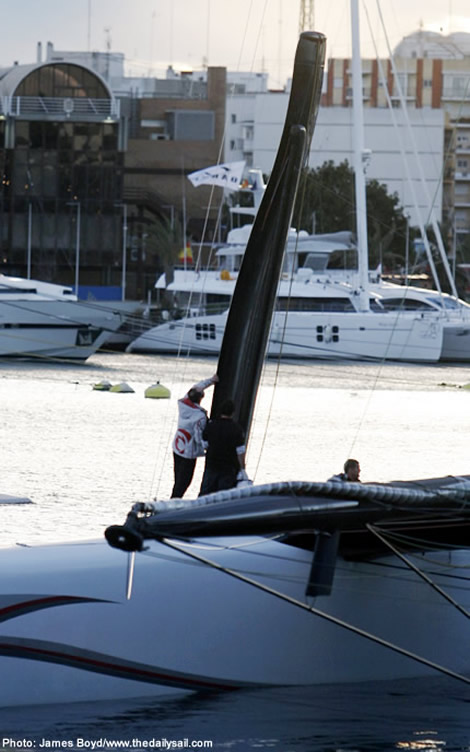
Stiffness
One difference between the Alinghi and BMW Oracle boats is that Alinghi 5 has been set up so that despite being a catamaran (which are usually weaker in this respect) she appears to have a more rigid structure both laterally and fore and aft than the trimaran, thanks to her unique Y-shaped ‘spine’ structure. We have never seen a catamaran, particularly a big one, with such little forestay sag.
"Our main aim was to have a very solid rig and sail set-up to get the maximum performance out of the sail plan," states Vrolijk. “To achieve that we all know that from the monohulls, this is an area where the multihulls have never been developed, because they have never been under such pressure because they were either reaching or offshore racing. The emphasis on keeping the sail shapes right and going upwind at very tight angles, has never been a problem with multihulls up until now. So we have gone into this new region. Version 5 boats are the same - they do angles upwind at speeds normal monohulls don’t do either. Now with the multihulls it is exactly the same. We are in an area where we think it is so important that we really try to optimise for that, which is why our whole configuration is done for that.”
The spine structure has made it easier to make Alinghi 5 equally stiff fore and aft to her American counterpart Vrolijk says because all they have to do is increase the diameter of the carbon rigging bracing the spine system - a much lighter solution than adding laminate or structure to USA’s centre hull.
Both teams have also put their boats on very very strict weight loss regimes, as this plays a much more vital role in the performance of a multihull than it does for a monohull. "It is a combination of weight, stability and sail area," says Vrolijk of the main performance drivers of a multihull. "With monohulls it is more a matter of length."
On the legally sensitive topic of water ballast, Vrolijk categorically states that their use of it isn’t to increase their water line length. "We use it for stability reasons, like you do on the lakes, and for manoeuvring. It just extends your range and that is the logical thing to do."
Given more time (and money) Vrolijk says they would certainly have built a second boat, as he compares what they have done to BMW Oracle’s trimaran being in this third or fourth configuration. "Their boat has nothing to do with what they had originally. They are now much closer to our boat than they ever were before. They have tried to match our concept. We still have our version 1 boat. We would love to have a version 2 if we could." Equally in all likelihood they would also have built a solid wing sail too. The crew and co-designer of Steve Clark’s C-Class, Cogito, Duncan MacLane is on the Alinghi payroll.
Saying this, Vrolijk at present isn’t 100% convinced by the solid wing sail. He says the only available comparison was in 1988 with Dennis Conner's Stars & Stripes campaign, which built two catamaran platforms and trialled the softsail rigs against the solid wing sail, the latter proving very much faster - or in fact 5% according to former crewman, Cam Lewis. However Vrolijk says that in fact little could be gauged from this simply because their solid wing was bigger than the softsail. "In the end they chose the wing, only because it was the best optimised and it was the last one they developed and I think it is a little bit the same if you compare the wing with the soft sail we have. Depending upon the development stage it will depend on which one is better in the conditions."
Mr Kramer's sleepless nights
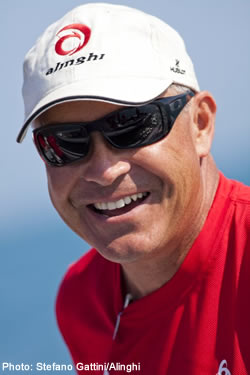 A key part of the development of both team’s boats has been their work up and development. Unlike Version 5 boats there are no scantlings to build to and so the engineering tolerances of both boats has been parred down to the minimum. This has combined dangerously with the boats being so large and so cutting edge. Also both teams have only built one platform and so haven’t been able to carry out the fast track development achievable with two boats. In addition after 17 years of refinement, the previous ACC monohulls were highly refined bits of kit where only tiny developments were possible - some way from the major multi-knot leaps in performance achievable from these big multis.
A key part of the development of both team’s boats has been their work up and development. Unlike Version 5 boats there are no scantlings to build to and so the engineering tolerances of both boats has been parred down to the minimum. This has combined dangerously with the boats being so large and so cutting edge. Also both teams have only built one platform and so haven’t been able to carry out the fast track development achievable with two boats. In addition after 17 years of refinement, the previous ACC monohulls were highly refined bits of kit where only tiny developments were possible - some way from the major multi-knot leaps in performance achievable from these big multis.
Mastermind behind the engineering of Alinghi 5 as well as some of its conception (being a near neighbour of C-Class guru Steve Clark’s in his native Rhode Island, but also having been involved with Stars & Stripes in 1988) is Dirk Kramers and it is he, with his structures team and CFD specialist Michel Richelson, who have had to put their point on the board when it came to how strongly the Swiss cat should be built. As mentioned, light weight is king when it comes to multihull performance and so in some areas Alinghi 5 has been almost under-built and subsequently beefed up, on the basis that this is easier to achieve than the reverse process reverse, overbuilding, then parring back.
To achieve this, as we have reported in the past, they built up a load case from various sources, the principle one being Bertarelli’s 41ft cat - all of which have been built into Michel Richelson’s VPP. The boat was constructed with more than 150 fibre optics load sensors dotted around it in key areas and these act as an early warning system in the event of a component or part of the boat being on the verge of self-destruction.
"I am sleeping at night, but the stress levels are sometimes a little too high when things break from time to time, but that is part of the deal of life at the edge," says Kramers with a brave smile. "We spend an enormous amount of effort trying to nip things in the bud before they happen, because we are in completely new territory here. There is no experience we can fall back on, so we’ve had to have some pretty elaborate systems in place to make sure big disasters don’t happen."
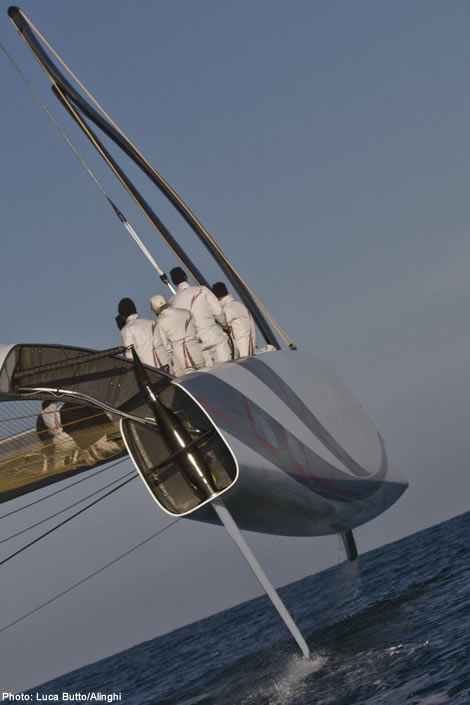 The is the photo caption
The is the photo caption
The present fibre optic system Alinghi used in the 32nd AC, but to nothing like the same extent as it has been used in the big cat. This is providing a much more comprehensive load case for the boat, some of it welcome confirmation, other parts, particularly dynamic loads as the boat is sailing, distinctly alarming. "Before you’d design on load cases with factors of safety and within those factors of safety you bury all the uncertainties - in your analysis methods, your load cases, the materials, dynamics and so on," says Kramers. "But now we get a peak inside that margin and that forces you to look at things in a different way that we’ve never had a chance to do before. Because we are playing with such big marbles here we have to be conservative on the one side, but if you are too conservative you make things too heavy and you are not going to win either, so you are stuck between a rock and a hard place."
According to Kramers the fibre optic system isn’t just to prevent them snapping the boat, it is also to develop Alinghi 5’s performance.
Of course the load model for the boat is ever evolving and changes whenever new sails are brought into play or daggerboards are changed, but particularly when the rig goes up to 60m and the forward spine is lengthened... So in each case it changes the limits the boat can be sailed to.
"The fibre optics are a fantastic tool. I think we wouldn’t be able to do without it any more. But if it doesn’t work it is a major!" quips Kramers. However significantly they have helped him to reduce down the engineering tolerances in some areas. "Because of this system we are having a peak inside this factor of safety window and it is very tempting on the one side to say 'we don’t need as big a factor of safety', but on the other side you know a whole lot more that you’d almost rather not know!"
The ultimate aim of the race boat engineer is to chase loads around a boat so that hopefully in theory once point ‘x’ is reached, the entire structure will self-destruct simultaneously. Kramers compares it to a giant house of cards. "If one item breaks, the whole thing can come down. That is why we are so careful. Even small things can snowball into something really bad. That is why we have inspection guys over it the whole time."
While with two or three hulls and crossbeams, plus the spine system on Alinghi 5, the load case of a giant multihull might seem to be way more complicated than that of a monohull with a keel stuck under it, but Kramers says in fact the opposite is truer because stability is highest when the hull of their catamaran is just flying. Once the weather hull is airborne the load case doesn’t change dramatically. "It does change according to how you are ballasted and how you set up your rig, but there are not a wide range of heel angles you play with, it is a fairly narrow stability window."
If the load case is simpler, Kramers says they have had to go back to ‘basis physics’ to analyse multihulls and develop their model since multihulls are much more sensitive to roll, pitch and yaw than V5 leadmines. "We have all seen boats pitchpole - so they are pitch sensitive and heel is sensitive because you are on a tiny narrow little hull. And then the normal yaw balance – how much do you load the rudder or the board or keel? So our VPP takes that into a much greater detail than we’ve ever done before. So it is quite exciting that we have been able to do this for this project."
Still the biggest area of development remains, according to Kramers, rig and foils. On the sails side, the game has changed dramatically since 2007. On the V5 boats there were times when they would go into a race with as many as 12 sails on board, mostly stuffed into the bow. For reasons of weight, this time they are unlikely to sail with more than the three or four you see. "I think in our last campaign we built something like 250 sails over the course of the four year campaign. This time it’ll be 115-120. But they are a bit larger though!" states Kramers.
On the topic of their lack of two boating this time Kramers says they have been fortunate that improvements to these giant multihulls (at this stage of their development at least) comes in whole knots, rather than 10ths or 100ths of a knot as was the case in with the V5 boats. "Thank God the speed differences are big otherwise we’d be really struggling. If you go one boat testing with an old boat you’d be lost, you’d never get anywhere. But with multihulls the differences are so big, you can actually learn something."
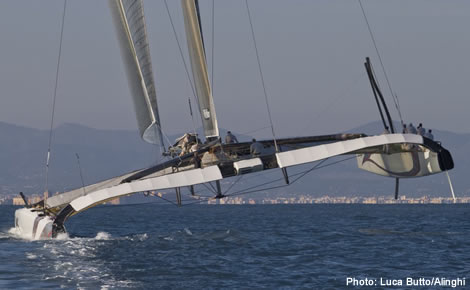
So the million dollar question is weight - it is thought that the BMW Oracle Racing tri is around 15 tonnes. Rolf Vrolijk reckons that Alinghi 5 is that vicinity too, but hopefully lighter. Without the centre hull, the cat configuration has traditionally been lighter than the tri, but Alinghi has her spine system instead of a centre hull, making this less clear cut. You might think that the catamaran would have more structure in its cross beams due to their unsupported span, but in fact the demands placed on the cross beams are the same in terms of athwartships structure as both mostly sail only with their leeward hull in the water. However Alinghi 5 gains in this respect as she has 2-2.5m less beam, so her cross beams could be lighter than those on the tri.
When it comes to the relative rigidity between Alinghi 5 and the USA tri, Kramers says that one of the problems with the tri is that you get more racking between the hulls. "That is exasperated by the fact that they have their shroud quite far back in the boat which is normal for an offshore trimaran. We think it is a bad thing - it absorbs lots of energy and if you end up in dynamic conditions, It can absorb some of the energy that might otherwise break you, but on the other hand that energy that you can use to drive yourself forward...”
We talk about the Gougeon brothers-designed Formula 40 trimaran, Adrenalin which had floats that hinged, allowing them to rock up and down fore and aft to reduce pitching as they went over waves. Kramers is very familar with this boat having at one time designed the rig for it, but advises that over the last 20 years it has bigger and bigger springs fitted to the limit hinges!
Ultimately as we said in our form guide, the outcome of the 33rd America’s Cup will come down to reliability and then strength versus weight. "Hopefully you don’t have to roll the dice, you can stack chances in your favour if you do your job right," concludes Kramers.
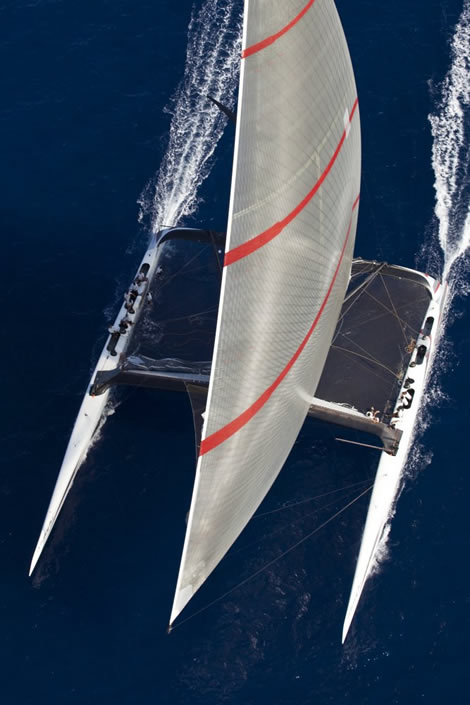









Latest Comments
James Boyd 12/02/2010 - 22:19
My what a super articleAdd a comment - Members log in